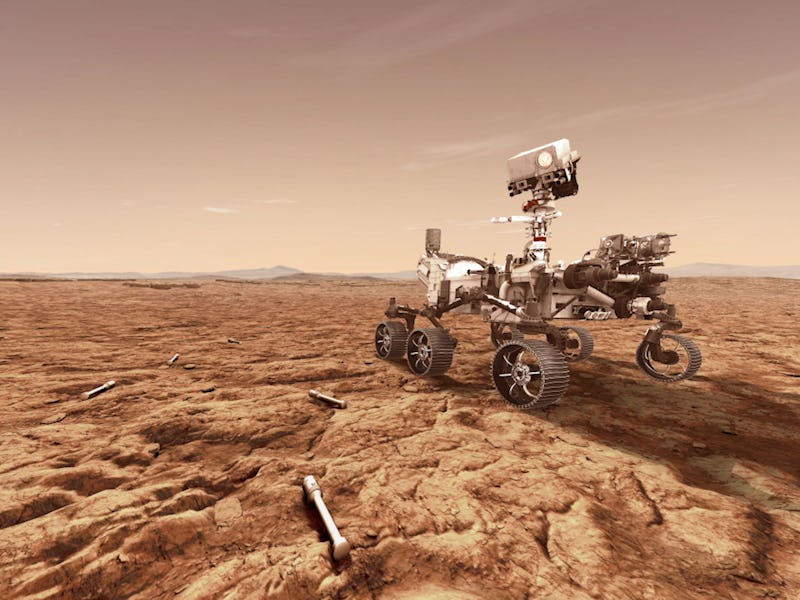Listen: Perseverance captures the eerie sounds of Mars and Ingenuity
NASA released five hours of new recordings.

Mars, it seems, is all about the bass.
Scientists have long known that the Red Planet’s cold, thin atmosphere acts like a low-pass filter, muffling higher frequencies and giving sounds a fat low end.
But with five hours of new recordings taken by NASA’s Perseverance Rover, you can hear the sounds of Mars itself as well the rover as it ranges over the Martian surface. As NASA explained in an article on Monday, Perseverance is the first vehicle to record the Martian soundscape with dedicated microphones.
Beyond simply sounding cool, the recordings are important scientific data: The rover’s microphones also picked up the low-frequency throbbing, thrumming, whir of the Ingenuity helicopter’s rotor blades flying more than 260 feet away. This recording helped scientists eliminate two incorrect models for how sound propagates on Mars.
What does Mars sound like?
In a NASA video about the new recordings, you can hear an array of Martian sounds, beginning with the thick, burbling murmur and occasional whipping sounds of the Martian wind. It sounds a bit like standing next to a flag in a strong wind at the south pole with big ear muffs on — the sound of desolation.
The sounds of the Perseverance Rover itself are also captured: Its metal wheels scrolling over the Martian sand sound a bit like listening to Darth Vader awkwardly hauling an oil drum down a narrow spaceship corridor.
Ingenuity’s recording is extremely faint — but there. The fact that Perseverance was able to pick up whispers of Ingenuity’s whirring suggests the Martian atmosphere can propagate sound further than previously realized.
But you had best take a listen for yourself — it starts at around minute 1:53 in the video below. Headphones are recommended.
NASA video revealing the sounds of the Martian wind and other sounds on the Red Planet.
How can Perseverance capture sound on Mars?
Perseverance is NASA’s latest Mars rover. It landed on the Red Planet on February 18, 2021.
In the months since Perseverance has been drilling rock samples for return to Earth by later missions and taking photos and exploring the Jezero Crater. In March it beamed back its first audio — confirmation that its microphones were working. These recordings revealed the sound of wind and the rover testing its instruments.
The locations of the microphones on the rover.
Perseverance also served as the delivery vehicle for the Ingenuity helicopter, which, after demonstrating the first powered, controlled flight in an atmosphere other than Earth’s, returned the favor by scouting the path ahead for Perseverance.
Perseverance is also the first Mars mission to include a pair of dedicated microphones for recording sounds in the environment, with one camera on the rover chassis and the other on its camera mast. Rather than custom microphones, Perseverance is using DPA 4006 Omnidirectional microphones, which you can pick up from an array of online retailers yourself for about $2,400.
A brief history of recording sounds in space — Perseverance is not the first NASA mission that has attempted to record sounds on Mars. The Mars Polar Lander, part of the 1998 Mars Surveyor mission, would have recorded sound, but was lost when attempting to land on Mars in December 1999.
The Phoenix Lander successfully touched down on Mars in May of 2008, but the microphone it carried with it was left off due to concerns it could cause technical problems for the lander.
The Soviet Venera 13 spacecraft was the first mission to record audio in an alien atmosphere during its 127-minute life on the hellish surface of Venus in 1981. And in January 2005, the European Space Agency’s Huygens probe recorded the sound of the wind as it descended to the surface of Saturn’s moon Titan.
But recording space sounds in alien atmospheres remains a relatively rare endeavor. Our abilities to hear are limited, considering much of the “noise” in space is carried at frequencies beyond that of audible sound.
NASA does maintain a webpage with clips of “spooky” sounds from around the Solar System that are really what higher energy radiation — Jupiter’s magnetic field, Saturn’s radio emissions, and the solar wind — sounds like when translated into frequencies humans can hear.